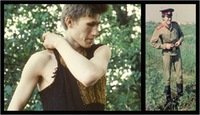According to the article “Kampas did not Want a Monument on his Grave”. Audronė Jablonskienė, Respublika, 2004 02 28
When the ten-year death anniversary of Rimvydas Jankauskas-Kampas (1957-1993) was commemorated, the friends and close people brought what they had. Being alive, the painter gave his paintings to various people as gifts even thought some solid buyers from Germany came to buy them during the last years. When the catalogue of the painter’s works was published after his death in 1994, the list of 126 works is indicated, where more than half of them are marked with stars, which means that they are considered disappeared. Many of his works are preserved in private collections. The largest of them is the collection of Kampas' daughter Simona Jankauskaitė who is presently living in the USA.
The most impressive of Kampas’ works is “Synagogue" covering the entire wall and burning with bright red colour, energetic strokes of the brush and unrestrained energy. The painting "Black Sun" is like a travel to the other shore after death. It is one of the last works and seems like the prediction of his own death.
A frequent object of Kampas’ paintings are synagogues – blue, red, big, small. The canvases are called "Synagogue", "Good bye, Synagogue", "Forlorn Synagogue"... According to art critics, canvases with the motive of a synagogue are the most mature works of Kampas. The workshop of the painter was also established in a synagogue.
Rimvydas Jankauskas-Kampas was married two times and divorced both times, he has left a daughter and son (Simona is 26, and Vytautas -13 today). All the women around him cherish the memories about him as something sacred. No doubt, the artist was a man of tragic outlook. He did everything to the extreme end – worked, loved and abused alcohol. Drugs and alcohol were like doping to him, a method to appear behind the border. Kampas died at the age of 36 due to the deathly intoxication with alcohol. He did not want any monument built on his grave…
Today the painter R.Jankauskas-Kampas is called one of the brightest artists of his generation, the symbol of the disappeared Kaunas bohemia, a genius that burned himself down. His works are still waiting for researchers and the colourful personality – for a memoir-book.









